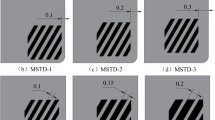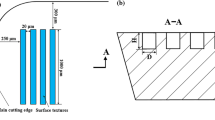Abstract
Surface textures were made using laser on the rake or flank face of the cemented carbide (WC/Co) inserts. Molybdenum disulfide solid lubricants were filled into the textured grooves to form self-lubricating textured tools. Dry cutting tests on Ti-6Al-4V were carried out with these self-lubricating textured tools and conventional tool. The machining performance was assessed in terms of the cutting forces, cutting temperature, chip thickness ratio, friction coefficient at the tool–chip interface, and tool wear. Results show that the cutting forces and cutting temperature of the self-lubricating textured tools were reduced compared with that of the conventional tool. The application of the self-lubricating textured tool with elliptical grooves on its rake face can reduce the tool–chip friction coefficient and the chip thickness ratio. The tool life of the textured tools is improved compared with that of the conventional tool. The effectiveness of the self-lubricating textured tools in improving cutting performance is related to the cutting parameter.
Similar content being viewed by others
References
Chen RY (1992) Principle of metal cutting. China Machine, Beijing
Deng JX, Song WL, Zhang H (2009) Design, fabrication and properties of a self-lubricated tool in dry cutting. Int J Mach Tools Manuf 49:66–72
Liu ZF, Zhang CG, Ren JL (2005) Dry machining technology and application. China Machine, Beijing
Deng JX, Ai X, Feng YH (2002) Wear lubrication and matching of cutting tools with the work piece materials. Chinese J Mech Eng 38(4):40–45
Zhao J, Ai X, Lu ZJ (2006) Preparation and characterization of Si3N4/TiC nanocomposite ceramics. Mater Lett 60:2810–2813
Li B, Deng JX, Wu Z (2010) Effect of cutting atmosphere on dry machining performance with Al2O3/ZrB2/ZrO2 ceramic tool. Int J Adv Manuf Technol 49:459–467
Renevier NM, Hamphire J, Fox VC (2001) Advantages of using self-lubricating, hard, wear-resistant MoS2-based coatings. Surf Coat Technol 142–144:67–77
Renevier NM, Oosterling H (2003) Performance and limitations of MoS2/Ti composite coated inserts. Surf Coat Technol 172(1):13–23
Song WL, Deng JX, Wu Z, Zhang H, Yan P, Zhao J, Ai X (2011) Cutting performance of cemented-carbides-based self-lubricated tool embedded with different solid lubricants. Int J Adv Manuf Technol 52:477–485
Deng JX, Cao TK, Yang XF (2006) Self-lubrication of sintered ceramic tools with CaF2 additions in dry cutting. Int J Mach Tools Manuf 46(9):957–963
Basnyat P, Luster B, Muratore C, Voevodin A-A, Haasch R, Zakeri R, Kohli P, Aouadi S-M (2008) Surface texturing for adaptive solid lubrication. Surf Coat Technol 203:73–79
Shen C, Huang W, Ma GL, Wang XL (2009) A novel surface texture for magnetic fluid lubrication. Surf Coat Technol 204:433–439
Pettersson U, Jacobson S (2003) Influence of surface texture on boundary lubricated sliding contacts. Tribol Int 36:857–864
Wang Y, Mo YF, Zhu M, Bai MW (2008) Wettability of metal coatings with biomimic micro textures. Surf Coat Technol 203:137–141
Lei S, Devarajan S, Chang ZH (2009) A study of micropool lubricated cutting tool in machining of mild steel. J Mater Process Technol 209:1612–1620
Enomoto T, Sugihara T (2010) Improving anti-adhesive properties of cutting tool surfaces by nano-/micro-textures. CIRP Ann Manuf Technol 59:597–600
Sugihara T, Enomoto T (2009) Development of a cutting tool with a nano/micro-textured surface-improvement of anti-adhesive effect by considering the texture patterns. Precis Eng 33:425–429
Kawasegi N, Sugimori H, Morimoto H, Morita N, Hori I (2009) Development of cutting tools with microscale and nanoscale textures to improve frictional behavior. Precis Eng 33:248–254
Koshy P, Tovey J (2011) Performance of electrical discharge textured cutting tools. CIRP Ann Manuf Technol 60:153–156
Deng JX, Wu Z, Lian YS, Qi T, Cheng J (2012) Performance of carbide tools with textured rake-face filled with solid lubricants in dry cutting processes. Int J Refract Met Hard Mater 30:164–172
Siekmann HJ (1995) How to machine titanium. Tool Engineer 34(1):78–82
Sun J, Guo YB (2009) Material flow stress and failure in multiscale machining titanium alloy Ti-6Al-4V. Int J Adv Manuf Technol 41:651–659
Sadeghi MH, Haddad MJ, Tawakoli T, Emami M (2009) Minimal quantity lubrication-MQL in grinding of Ti-6Al-4V titanium alloy. Int J Adv Manuf Technol 44:487–500
Zhang S, Li JF, Deng JX, Li YS (2009) Investigation on diffusion wear during high-speed machining Ti-6Al-4V alloy with straight tungsten carbide tools. Int J Adv Manuf Technol 44:17–25
Zhou ZH (1992) Metal-cutting principles. China Machine, Beijing
Hasçalık A, Çaydaş U (2008) Optimization of turning parameters for surface roughness and tool life based on the Taguchi method. Int J Adv Manuf Technol 38:896–903
Li AH, Zhao J, Luo HB, Pei ZQ, Wang ZM (2011) Progressive tool failure in high-speed dry milling of Ti-6Al-4V alloy with coated carbide tools. Int J Adv Manuf Technol. doi:10.1007/s00170-011-3408-1
ISO 3685 (1993) Tool life testing with single point turning tools. International Organization for Standardization, Geneva
Author information
Authors and Affiliations
Corresponding author
Rights and permissions
About this article
Cite this article
Ze, W., Jianxin, D., Yang, C. et al. Performance of the self-lubricating textured tools in dry cutting of Ti-6Al-4V. Int J Adv Manuf Technol 62, 943–951 (2012). https://doi.org/10.1007/s00170-011-3853-x
Received:
Accepted:
Published:
Issue Date:
DOI: https://doi.org/10.1007/s00170-011-3853-x




